Atomic Layer Deposition to Fine-Tune the Surface Properties and Diameters of Fabricated Nanopores
- PMID: 24991194
- PMCID: PMC4076156
- DOI: 10.1021/nl0494001
Atomic Layer Deposition to Fine-Tune the Surface Properties and Diameters of Fabricated Nanopores
Abstract
Atomic layer deposition of alumina enhanced the molecule sensing characteristics of fabricated nanopores by fine-tuning their surface properties, reducing 1/f noise, neutralizing surface charge to favor capture of DNA and other negative polyelectrolytes, and controlling the diameter and aspect ratio of the pores with near single Ångstrom precision. The control over the chemical and physical nature of the pore surface provided by atomic layer deposition produced a higher yield of functional nanopore detectors.
Figures




References
-
- Bayley H, Cremer PS. Nature. 2001;413:226. - PubMed
-
- Li J, Stein D, McMullan C, Branton D, Aziz MJ, Golovchenko JA. Nature. 2001;412:166. - PubMed
-
- Storm AJ, Chen JH, Ling XS, Zandbergen HW, Dekker C. Nature Materials. 2003;2:537. - PubMed
-
- Siwy Z, Dobrev D, Neumann R, Trautmann C, Voss KO. Appl. Phys. A. 2003;76:781.
-
- Lev AA, Korchev YE, Rostovtseva TK, Bashford CL, Edmonds DT, Pasternak CA. Proc. R. Soc. London B. 1993;252:187. - PubMed
Grants and funding
LinkOut - more resources
Full Text Sources
Other Literature Sources
